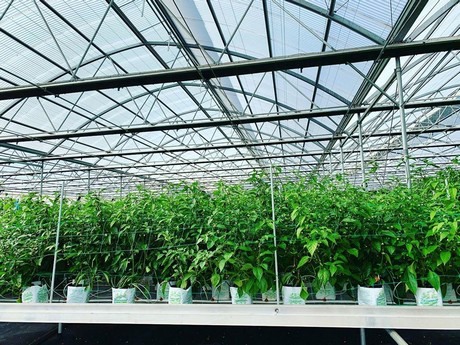Every grower knows that the key to healthy plants is in the soil through the nutrients. A plant requires sixteen different minerals and nutrients that can be obtained primarily through the soil – with a few coming from the air collected during natural plant processes. More times than not, the soil needs to be amended with fertilizers to help the plant grow throughout the whole growth cycle. It is important that a grower performs soil tests and uses the correct mixture of fertilizers to prevent excessive run-off or other health problems related to over application.
The key to what type of fertilizer to use is all in the label of the product and comparing to the soil/growing media test results. On standard fertilizer bags, there are typically three numbers on the front of the bag. Standard fertilizers have varying concentrations of three key nutrients plants need in larger quantities. These macronutrients are nitrogen, phosphorous, and potassium (N,P,K). These numbers translate to the percent of the specific nutrient in the bag by weight. If a bag reads 12-12-12, it translates to 12% Nitrogen, Phosphorus, and Potassium. When a fertilizer contains all three of Nitrogen, Phosphorus, and Potassium, it is called a “complete” fertilizer. The numbers are not always equal and can be customized to the specific needs of the grower in custom mixes done either by request in bulk to a company or mixed by hand by the grower. Fertilizers can have the option to contain only two or one of the three as well. For micronutrients that are lacking, a fertilizer may need to be one such as bone meal or lime to control a soil component instead of a standard fertilizer mix.
To determine what is needed in the fertilizer mix, it is important to conduct regular soil tests to ensure that the plants need the application and to ensure there is no under or over application of nutrients. Depending on the plant nutrient or mineral being applied, the plant may experience negative effects such as burning of the leaf tissues or damage to roots. Each nutrient or mineral needed by a plant has a main function or role it plays in the growth of the plant.
Nitrogen boosts green growth of the plant and helps during the vegetative growth stage, phosphorus allows for excellent root growth, and potassium promotes vigorous growth and hardiness of a plant.
There are several types of fertilizers on the market each coming in one of three ways. There are organic fertilizers that are composed of “natural” by-products such as manure and compost. The other type of fertilizer is inorganic fertilizers. These are made of chemical compounds mixed to meet nutrient requirements. Organic fertilizers are typically for slow release of nutrients and minerals for the uptake by the plant. Inorganic fertilizers are more immediate and are used to supplement quickly. These fertilizers can be applied in many forms-liquid, powder, and granular form. The methods of application depend on the form the fertilizer is in.
The use of fertilizer is important in the successful operation of a commercial plant growing operation. Care should be given in the application and specific amounts of fertilizer in order to get the most out of the application and budget. Reading the labels on the containers and the soil test results is essential in the selection and timing of application with the correct fertilizer.

Many companies create fertilizers that are premade mixes that are suitable for a commercial operation to use. RedFlag Blends is an advanced plant nutrient manufacturer specializing in developing and bringing to market plant nutrients, additives, and supplements for large-scale commercial growers, greenhouses, CEA facilities, indoor farms, vertical farms, and in field farming operations. RedFlag Blends offers pH up and pH down solutions, bloom nutrients for soil and hydroponic operations, grow nutrients for soil and hydroponic operations, different types of plant nutrient blends, extraction solvents, and more.
Knowing what the numbers mean is important in the correct selection and application that the plants need. This is true for every type of growing operation from hydroponics and traditional soil grown operations. RedFlag offers a line of hydroponic fertilizer solutions for the use in any water based growing system. The RF Bloom Hydroponic Formulation Blue is a 0-12-32 blend. This translates to a blend with zero percent nitrogen, twelve percent phosphorus, and thirty two percent potassium. In another RedFlag blend, the Hydroponic Formulation 5-10-30, the breakdown of nutrients in the fertilizer is instead five percent nitrogen, ten percent phosphorus, and thirty percent potassium by weight. In traditional cultivation, fertilizer application can be in a solid or liquid form. The numbers still mean the same in regards to the amount of nutrients in the formula. For example the Red Flag blend Grow 5-10-33 will have five percent nitrogen, ten percent phosphorus, and thirty three percent potassium.
Some labels will show an additional number or numbers with a plus sign following the NPK numbers. These numbers are additional nutrients added to a fertilizer mix. The number will have the chemical formula for the added nutrient after it. The number stands for the percent by weight- just like the NPK numbers. These numbers on the label will never go above a hundred. For example, the Haifa Chemical blend Calcium Nitrate fertilizer will show a number configuration of 15.5-0-0 + 26.5 CaO. This translates to fifteen and a half percent nitrogen, and zero percent phosphorus and potassium. The Calcium is then an additional twenty six and a half percent of the formula. Although these number labels can look intimidating especially with advanced and more specific mixes, a grower can rest assured that the placement of the numbers are predictable and additional additives are directly labeled after the NPK numbers.
For more information: RF Agriculture
RF Agriculture
www.rfagriculture.com
